- Home »
- JAPANESE CULTURE
// Posted by :Unknown
// On :Friday, 6 July 2012
HISTORY OF JAPAN
The history of Japan encompasses the history of the islands of Japan and the Japanese people, spanning the ancient history of the region to the modern history of Japan as a nation state. Following the last ice age, around 12,000 BC, the rich ecosystem of the Japanese Archipelago fostered human development. The earliest-known pottery belongs to the Jōmon period. The first known written reference to Japan is in the brief information given in Twenty-Four Histories in the 1st century AD. The main cultural and religious influences came from China.
 The first permanent capital was founded at Nara in 710 AD, which became a center of Buddhist art, religion and culture. The current imperial family emerged about 700 AD, but until 1868 (with few exceptions) had high prestige but little power. By 1550 or so political power was subdivided into several hundred local units, or "domains" controlled by local "daimyō" (lords), each with his own force of samurai warriors. Tokugawa Ieyasu came to power in 1600, gave land to his supporters, set up his "bakufu" (military government) at Edo (modern Tokyo). The "Tokugawa period" was prosperous and peaceful, but Japan deliberately terminated the Christian missions and cut off almost all contact with the outside world. In the 1860s the Meiji Period began, and the new national leadership systematically ended feudalism and transformed an isolated, underdeveloped island country into a world power that closely followed Western models. Democracy was problematic, because Japan's powerful military was semi-independent and overruled—or assassinated—civilians in the 1920s and 1930s. The military moved into China starting in 1931 and declared all-out war on China in 1937. Japan controlled the coast and major cities and set up puppet regimes, but was unable to defeat China. Its attack on Pearl Harbor in December 1941 led to war with the United States and its allies. After a series of naval victories by mid-1942, Japan's military forces were overextended and its industrial base was unable to provide the needed ships, armaments and oil. Even with his navy sunk and his main cities destroyed by air, the Emperor held out until August 1945 when two atomic bombs and a Soviet invasion forced a surrender. Occupied by the U.S. after the war and stripped of its entire empire, Japan was transformed into a peaceful and democratic nation. After 1950 it enjoyed very high economic growth rates, and became a world economic powerhouse, especially in engineering, automobiles and electronics. Since the 1990s economic stagnation has been a major issue, with an earthquake and tsunami in 2011 causing massive economic dislocations and loss of the nuclear power supply.
The first permanent capital was founded at Nara in 710 AD, which became a center of Buddhist art, religion and culture. The current imperial family emerged about 700 AD, but until 1868 (with few exceptions) had high prestige but little power. By 1550 or so political power was subdivided into several hundred local units, or "domains" controlled by local "daimyō" (lords), each with his own force of samurai warriors. Tokugawa Ieyasu came to power in 1600, gave land to his supporters, set up his "bakufu" (military government) at Edo (modern Tokyo). The "Tokugawa period" was prosperous and peaceful, but Japan deliberately terminated the Christian missions and cut off almost all contact with the outside world. In the 1860s the Meiji Period began, and the new national leadership systematically ended feudalism and transformed an isolated, underdeveloped island country into a world power that closely followed Western models. Democracy was problematic, because Japan's powerful military was semi-independent and overruled—or assassinated—civilians in the 1920s and 1930s. The military moved into China starting in 1931 and declared all-out war on China in 1937. Japan controlled the coast and major cities and set up puppet regimes, but was unable to defeat China. Its attack on Pearl Harbor in December 1941 led to war with the United States and its allies. After a series of naval victories by mid-1942, Japan's military forces were overextended and its industrial base was unable to provide the needed ships, armaments and oil. Even with his navy sunk and his main cities destroyed by air, the Emperor held out until August 1945 when two atomic bombs and a Soviet invasion forced a surrender. Occupied by the U.S. after the war and stripped of its entire empire, Japan was transformed into a peaceful and democratic nation. After 1950 it enjoyed very high economic growth rates, and became a world economic powerhouse, especially in engineering, automobiles and electronics. Since the 1990s economic stagnation has been a major issue, with an earthquake and tsunami in 2011 causing massive economic dislocations and loss of the nuclear power supply.
JAPANESE CLOTHING
Samurai
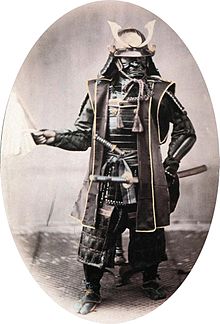 Samurai (侍?) were the military nobility of pre-industrial Japan. According to translator William Scott Wilson: "In Chinese, the character 侍 was originally a verb meaning to wait upon or accompany a persons in the upper ranks of society, and this is also true of the original term in Japanese,saburau. In both countries the terms were nominalized to mean "those who serve in close attendance to the nobility," the pronunciation in Japanese changing to saburai. According to Wilson, an early reference to the word "samurai" appears in the Kokin Wakashū (905–914), the first imperial anthology of poems, completed in the first part of the 10th century.
Samurai (侍?) were the military nobility of pre-industrial Japan. According to translator William Scott Wilson: "In Chinese, the character 侍 was originally a verb meaning to wait upon or accompany a persons in the upper ranks of society, and this is also true of the original term in Japanese,saburau. In both countries the terms were nominalized to mean "those who serve in close attendance to the nobility," the pronunciation in Japanese changing to saburai. According to Wilson, an early reference to the word "samurai" appears in the Kokin Wakashū (905–914), the first imperial anthology of poems, completed in the first part of the 10th century.
By the end of the 12th century, samurai became almost entirely synonymous with bushi (武士), and the word was closely associated with the middle and upper echelons of the warrior class. The samurai followed a set of rules that came to be known as bushidō. While they numbered less than 10% of Japan's population samurai teachings can still be found today in both everyday life and in modern Japanese martial arts.
Kimono
The kimono (着物) is a Japanese traditional garment worn by men, women and children. The word "kimono", which literally means a "thing to wear" (ki"wear" and mono "thing"), has come to denote these full-length robes. The standard plural of the word kimono in English is kimonos, but the unmarked Japanese plural kimono is also sometimes used.
Kimono are T-shaped, straight-lined robes worn so that the hem falls to the ankle, with attached collars and long, wide sleeves. Kimono are wrapped around the body, always with the left side over the right (except when dressing the dead for burial.), and secured by a sash called an obi, which is tied at the back. Kimono are generally worn with traditional footwear (especially zōri or geta) and split-toe socks (tabi).
Today, kimono are most often worn by women, and on special occasions. Traditionally, unmarried women wore a style of kimono called furisode,with almost floor-length sleeves, on special occasions. A few older women and even fewer men still wear the kimono on a daily basis. Men wear the kimono most often at weddings, tea ceremonies, and other very special or very formal occasions. Professional sumo wrestlers are often seen in the kimono because they are required to wear traditional Japanese dress whenever appearing in public.
 A yukata (浴衣) is a Japanese garment, a casual summer kimono usually made of cotton or synthetic fabric, and are unlined. Yukata are worn by both men and women. Like other forms of traditional Japanese clothing, yukata are made with straight seams and wide sleeves. Men's yukata are distinguished by the short ~10cm sleeve extension from the armpit seam. Women's yukata are distinguished by the long ~20cm sleeve extension from the armpit seam. A standard yukata ensemble consists of a cotton undergarment(juban), yukata, obi, bare feet, sandals(geta), a foldable or fixed hand fan, and a carry bag (kinchaku). Kinchaku are used by both men and women to carry cellphones, sunglasses, wallets and tissue. For men, an optional hat or derby may also be worn to protect the head from the sun. yukata literally means bath(ing) clothes,though their use is not limited to after-bath wear. Yukata are a common sight in Japan during the hot summer months (starting in July).
A yukata (浴衣) is a Japanese garment, a casual summer kimono usually made of cotton or synthetic fabric, and are unlined. Yukata are worn by both men and women. Like other forms of traditional Japanese clothing, yukata are made with straight seams and wide sleeves. Men's yukata are distinguished by the short ~10cm sleeve extension from the armpit seam. Women's yukata are distinguished by the long ~20cm sleeve extension from the armpit seam. A standard yukata ensemble consists of a cotton undergarment(juban), yukata, obi, bare feet, sandals(geta), a foldable or fixed hand fan, and a carry bag (kinchaku). Kinchaku are used by both men and women to carry cellphones, sunglasses, wallets and tissue. For men, an optional hat or derby may also be worn to protect the head from the sun. yukata literally means bath(ing) clothes,though their use is not limited to after-bath wear. Yukata are a common sight in Japan during the hot summer months (starting in July).
Traditionally yukata were mostly made of indigo-dyed cotton but today a wide variety of colors and designs are available. As with kimono, the general rule with yukata is that younger people wear bright, vivid colors and bold patterns, while older people wear dark, matured colors and dull patterns. A child may wear a multicolored print and a young woman may wear a floral print, while an older woman would confine herself to a traditional dark blue with geometric patterns. Men in general my wear solid dark colors. Since the late 1990s, yukata have experienced a revival.
Yukata are worn at outdoor summer events such as hanabi fireworks displays and bon-odori festivals. Yukata are also worn at Japanese inns ''ryokan''after bathing.
JAPANESE FOOD
Sushi
Sushi (すし, 寿司, 鮨, 鮓, 寿斗, 寿し, 壽司) is a Japanese food consisting of cooked vinegared rice (shari) combined with other ingredients (neta). Neta and forms of sushi presentation vary, but the ingredient which all sushi have in common is shari. The most common neta is seafood.
Donburi
Donburi (丼, literally "bowl", also frequently abbreviated as "don", thus less commonly spelled "domburi") is a Japanese "rice bowl dish" consisting of fish, meat, vegetables or other ingredients simmered together and served over rice. Donburi meals are served in oversized rice bowls also called donburi. Donburi are sometimes called sweetened or savory stews on rice.
The simmering sauce varies according to season, ingredients, region, and taste. A typical sauce might consist of dashi flavored with soy sauce andmirin. Proportions vary, but there is normally three to four times as much dashi as soy sauce and mirin. For oyakodon, Tsuji (1980) recommends dashi flavored with light soy sauce, dark soy sauce, and sugar. For gyudon, Tsuji recommends water flavored with dark soy sauce and mirin.
Takoyaki
Takoyaki (たこ焼き or 蛸焼, literally fried or grilled octopus) is a ball-shaped Japanese snack made of a wheat flour-based batter and cooked in a special takoyaki pan. It is typically filled with minced or diced octopus, tempura scraps (tenkasu), pickled ginger, and green onion.Takoyaki are brushed with takoyaki sauce, a sauce similar to Worcestershire sauce, and mayonnaise. The takoyaki is then sprinkled with green laver (aonori) and shavings of dried bonito (katsuobushi). There are many variations to the takoyaki recipe. For example, ponzu i.e. soy sauce with dashi and citrus vinegar, goma-dare i.e. sesame-and-vinegar sauce or vinegared dashi. Takoyaki is associated with yatai street food stalls, but there are many well-established takoyaki specialty restaurants, particularly in Osaka and the Kansai region. Takoyaki is now sold at commercial outlets, such as supermarkets and 24-hour convenience stores.
Takoyaki was first popularized in Osaka,where a street vendor named Tomekichi Endo is credited with its invention in 1935. Takoyaki inspired by Akashiyaki, a small round dumpling from the city of Akashi, Hyōgo Prefecture made of an egg-rich batter and octopus.Takoyaki was initially popular in the Kansai region, but later spread to the Kantō region and other areas of Japan.
Yaki is derived from "yaku" (焼く) which is one of the cooking methods in Japanese cuisine, meaning "to fry or grill", and can be found in the names of other Japanese cuisine items such as teppanyaki, yakitori, teriyaki and sukiyaki.
Omurice
Omurice, sometimes spelled "omu-rice" (Japanese: オムライス, Omu-raisu), is an example of contemporary Japanese fusion cuisine (Yōshoku) consisting of an omelette made with fried rice and usually topped with ketchup.Omu and raisu being contractions of the words omelette and rice,the name is a wasei-eigo. It is a popular dish both commonly cooked at home and can be found at many western style diners and izakaya restaurants in Japan. It remained popular in Korea after Japanese occupation ended and it is a popular dish in many restaurants throughout South Korea today, where it is rendered as "오무라이스 (Oh-moo-rah-ee-seu)" in Hangul.The dish is also popular with children and often featured on okosama-ranchi orkids' meals.
The dish typically consists of chikin raisu (chicken rice: rice pan-fried with ketchup and chicken) wrapped in a thin sheet of fried egg. The ingredients that flavor the rice vary. Often, the rice is fried with various meats (but typically chicken) and/or vegetables, and can be flavored with beef stock, ketchup,demi-glace white sauce or just salt and pepper. Sometimes, the rice is replaced with fried noodles, yakisoba, instead of fried rice, to make omusoba. A variant in Okinawa is omutako, consisting of an omelet over taco rice. Fried hotdog or Spam are also two popular meats to include in the dish.
Omurice is said to have originated around the turn of the 20th century at a western style restaurant in Tokyo's Ginza district called Renga-tei, inspired by chakin-zushi.
Japanese Curry Rice
 Curry (カレー karē) is one of the most popular dishes in Japan. It is commonly served in three main forms: curry rice (カレーライス karē raisu?),karē udon (thick noodles) and karē-pan. Curry rice is most commonly referred to simply as 'curry' (カレー karē).
Curry (カレー karē) is one of the most popular dishes in Japan. It is commonly served in three main forms: curry rice (カレーライス karē raisu?),karē udon (thick noodles) and karē-pan. Curry rice is most commonly referred to simply as 'curry' (カレー karē).
A wide variety of vegetables and meats are used to make Japanese curry. The basic vegetables are onions, carrots, and potatoes. For the meat, beef, pork, and chicken are the most popular. Katsu-karē is a breaded deep-fried pork cutlet with curry sauce.
Curry was introduced to Japan during the Meiji era (1868–1912) by the British, at a time when India was under their administration. The dish became popular and available for purchase in supermarkets and restaurants in the late 1960s. It has been adapted since its introduction to Japan, and is so widely consumed that it can be called a national dish.
Soba
Soba (そば or 蕎麦) is the Japanese name for buckwheat. It is synonymous with a type of thin noodle made from buckwheat flour, and in Japancan refer to any thin noodle (unlike thick wheat noodles, known as udon). Soba noodles are served either chilled with a dipping sauce, or in hot broth as a noodle soup. It takes three months for buckwheat to be ready for harvest, so it can be harvested four times a year, mainly in spring, summer, and autumn. In Japan, buckwheat is produced mainly in Hokkaido.Soba that is made with newly harvested buckwheat is called "shin-soba". It is sweeter and more flavorful than regular soba.
In Japan, soba noodles are served in a variety of settings: they are a popular inexpensive fast food at train stations throughout Japan, but are also served by expensive specialty restaurants. Markets sell dried noodles and men-tsuyu, or instant noodle broth, to make home preparation easy.
Some establishments, especially cheaper and more casual ones, may serve both soba and udon as they are often served in a similar manner. Soba the traditional noodle of choice for Tokyoites.This tradition originates from the Tokugawa period, when the population of Edo (Tokyo), being considerably wealthier than the rural poor, were more susceptible to beri beri due to their high consumption of white rice, which is low inthiamine. It was discovered that beri beri could be prevented by regularly eating thiamine-rich soba. In the Tokugawa era, every neighborhood had one or two soba establishments, many also serving sake, which functioned much like modern cafes where locals would stop for a casual meal.
Ramen
Ramen (ラーメン rāmen) is a Japanese noodle dish. It consists of Chinese-style wheat noodles served in a meat- or (occasionally) fish-based broth, often flavored with soy sauce or miso, and uses toppings such as sliced pork (チャーシュー chāshū?), dried seaweed (海苔 nori),kamaboko, green onions, and occasionally corn. Almost every locality in Japan has its own variation of ramen, from the tonkotsu (pork bone broth) ramen of Kyushu to the miso ramen of Hokkaido.

Udon
Udon (饂飩, usually written as うどん) is a type of thick wheat-flour noodle of Japanese cuisine.
Udon is usually served hot as noodle soup in its simplest form as kake udon, in a mildly flavoured broth called kakejiru which is made ofdashi, soy sauce (shōyu), and mirin. It is usually topped with thinly chopped scallions. Other common toppings include tempura, oftenprawn or kakiage (a type of mixed tempura fritter), or aburaage, a type of deep-fried tofu pockets seasoned with sugar, mirin, and soy sauce. A thin slice of kamaboko, a halfmoon-shaped fish cake, is often added. Shichimi can be added to taste.
The flavor of broth and topping vary from region to region. Usually, dark brown broth, made from dark soy sauce (koikuchi shōyu) is used in eastern Japan, and light brown broth, made from light soy sauce (usukuchi shōyu) is used in western Japan. This is even noticeable in packaged instant noodles, which are often sold in two different versions for east and west.
Okonomiyaki
Okonomiyaki (お好み焼き o-konomi-yaki) is a Japanese savoury pancake containing a variety of ingredients. The name is derived from the wordokonomi, meaning "what you like" or "what you want", and yaki meaning "grilled" or "cooked" (yakitori and yakisoba). Okonomiyaki is mainly associated with Kansai or Hiroshima areas of Japan, but is widely available throughout the country. Toppings and batters tend to vary according to region. Tokyo okonomiyaki is usually smaller than a Hiroshima or Kansai okonomiyaki.
Dango
Dango (団子) is a Japanese dumpling made from mochiko (rice flour), related to mochi. It is often served with green tea. Dango are eaten year-round, but the different varieties are traditionally eaten in given seasons. Three to four dango are often served on a skewer.
Japanese festivals are traditional festive occasions. Some festivals have their roots in Chinese festivals but have undergone dramatic changes as they mixed with local customs.
Some are so different that they do not even remotely resemble the original festival despite sharing the same name and date. There are also various local festivals (Tobata Gion) that are mostly unknown outside a given prefecture. It is commonly said that you will always find a festival somewhere in Japan.
Unlike most people in East Asia, Japanese people generally do not celebrate Chinese New Year (it having been supplanted by the Western New Year's Day in the late 19th century); although Chinese residents in Japan still do. In Yokohama Chinatown, Japan's biggest Chinatown, tourists from all over Japan come to enjoy the festival. And similarly the Nagasaki Lantern Festival is based in Nagasaki's Chinatown. See: Japanese New Year.
Matsuri (Japanese Local Festivals)
There are no specific matsuri days for all of Japan; dates vary from area to area, and even within a specific area, but festival days do tend to cluster around traditional holidays such as Setsubun or Obon. Almost every locale has at least one matsuri in late summer/early autumn, usually related to the rice harvest.
Notable matsuri often feature processions which may include elaborate floats. Preparation for these processions is usually organized at the level of neighborhoods, or machi. Prior to these, the local kami may be ritually installed in mikoshi and paraded through the streets.
One can always find in the vicinity of a matsuri booths selling souvenirs and food such as takoyaki, and games, such as Goldfish scooping. Karaoke contests, sumo matches, and other forms of entertainment are often organized in conjunction with matsuri. If the festival is next to a lake, renting a boat is also an attraction.
Favorite elements of the most popular matsuri, such as the Nada no Kenka Matsuri of Himeji or the Neputa Matsuri of Hirosaki, are often broadcast on television for the entire nation to enjoy.
Sapporo Snow Festival
Sapporo Yuki Matsuri is one of the largest festivals of the year in Sapporo, held in February for one week. It began in 1950 when high school students built snow statues in Odori Park, central Sapporo. The event is now very large and commercialized. About a dozen large sculptures are built for the festival along with around 100 smaller snow and ice sculptures. Several concerts and other events are also held.
Lake Shikotsu Ice Festival
Lake Shikotsu is the northernmost ice-free lake which is 363 meters deep. This festival features a moss-covered cave, which has evergreen draped on the inside and is covered in ice (Gianola, 2008). This festival is held from late January to mid February. This festival features ice sculptures, small and large. At night the sculptures are illuminated by different colored lights. There is a fireworks show during the festival as well. Admission is free. Amasake (hot sake) is available for purchase to enjoy (2008 Ministry of Land).
Lake Towada Snow Festival
his lake festival is held in the beginning of February. Held in the town of Yasumiya, this festival is on the south side of lake Towada (near the wooden statues). This festival is open all day, but at 5pm one can enjoy activities such as going through a snow maze, exploring a Japanese igloo, and eat foods from Aomori and Akita prefectures. There is a fireworks show and events held on an ice stage.
Aomori Nebuta Festival
This festival is held annually and features colorful lantern floats called nebuta which are pulled through the streets of Central Aomori. This festival is held from about August 2–7 every year. This event attracts millions of visitors. During this festival, 20 large nebuta floats are paraded through the streets near Aomori JR rail station. These floats are constructed of wooden bases and metal frames. Japanese papers, called washi, are painted onto the frames. These amazing floats are finished off with the historical figures or kabuki being painted on the paper. These floats can take up to a year to complete. There is a dance portion of this festival. There are haneto dancers and they wear special costumes for this dance. Everyone is welcome to purchase their own haneto costume that they may too join in on the fun (Mishima, Aomori Nebuta Festival).
Nango Summer Jazz Festival
This event is held every year. Thousands of artists from all over Tohoku and even further regions come to Nango to perform. This is the largest open-air jazz concert held in Tohoku region. This festival began in 1989, in a small venue indoors. There was such a large response from the fans that is was expanded into a large annual festival. One must purchase tickets for this event (Bernard, 2007). This summer jazz festival doesn't cost anything but you still need to receive a ticket to enter.
Cherry Blossom Festivals
Japan celebrates the entire season of the cherry blossoms. All over Japan festivals are held which include food and at night beautiful lanterns. An interesting fact concerning cherry blossoms:
According to a study, plants in urban areas have plants that bloom are blooming faster. From evidence at a cherry arboretum at Mt. Takao, early flowering of the cherry blossoms is happening due to the larger response to temperature variation (Primack, Higuchi, & Miller-Rushing, 2009).
Some locations of cherry blossom festivals include:
- Yaedake Cherry Blossom Festival in Okinawa. This festival takes place from late January – mid February
- Matsuyama Shiroyama Koen Cherry Blossom Festival in Matsuyama-city, Ehime. This festival takes place early April.
- Matsue Jozan Koen Festival in Matsue-city, Shimane. This festival has a feature of illuminating the cherry blossom trees at night. This festival takes place late March-early April.
- Tsuyama Kakuzan Koen Cherry Blossom Festival in Tsuyama-city, Okayama. Japanese tea ceremonies and music performers are held at these festivals. This festival is held early-mid April.
- Takato Joshi Koen Cherry Blossom Festival in Takato-machi Ina-city, Nagano prefecture. The trees in this region have pink blossoms. This festival is held early April.
- Takada Koen Cherry Blossom Festival in Joetsu-city, Niigata prefecture. This festival is held early-mid April.
- Kitakami Tenshochi Cherry Blossom Festival in Kitakami-city, Iwate. This festival is held mid April-early May.
- Hirosaki Cherry Blossom Festival held in Hirosaki Koen Hirosaki-city, Aomori prefecture. This festival is held late April-early May (Mishima, Cherry Blossom Festivals 2010).
JAPANESE CULTURAL FESTIVAL - BUNKASAI (文化祭)
New Year Shogatsu (正月)
Information: New Year observances are the most elaborate of Japan's annual events. Before the New Year, homes are cleaned, debts are paid off, and osechi (food in lacquered trays for the New Year) is prepared or bought. Osechi foods are traditional foods which are chosen for their lucky colors, shapes, or lucky-sounding names in hopes of obtaining good luck in various areas of life during the new year. Homes are decorated and the holidays are celebrated by family gatherings, visits to temples or shrines, and formal calls on relatives and friends. The first day of the year (ganjitsu) is usually spent with members of the family.
People try to stay awake and eat toshikoshisoba, noodles to be eaten at midnight. People also visit Buddhist temples and Shinto shrines. Traditionally three are visited. This is called sansha-mairi. In the Imperial Palace at dawn on the 1st, the Emperor performs the rite of shihōhai (worship of the four quarters), in which he offers prayers for the well-being of the nation. On January 2 the public is allowed to enter the inner palace grounds; the only other day this is possible is the Emperor's birthday (December 23). On the 2nd and 3rd days acquaintances visit one another to extend greetings (nenshi) and sip otoso (a spiced rice wine). Some games played at New Year's are karuta (a card game), hanetsuki (similar to badminton), tako age (kiteflying), and komamawashi (spinning tops). These games are played to bring more luck for the year. Exchanging New Year's greeting cards (similar to Christmas Cards ) is another important Japanese custom. Also special allowances are given to children, which are called otoshidama. They also decorate their entrances with kagami mochi (two mochi rice balls placed one on top of the other, with a tangerine on top), and kadomatsu (pine tree decorations).
A later New Year's celebration, Koshōgatsu, literally means "Small New Year" and starts with the first full moon of the year (around January 15).The main events of Koshōgatsu are rites and practices praying for a bountiful harvest.
Doll Festival - Hina Matsuri (祭り)
Information: This is the day when families pray for the happiness and prosperity of their girls and to help ensure that they grow up healthy and beautiful. The celebration takes place both inside the home and at the seashore. Both parts are meant to ward off evil spirits from girls. Young girls put on their best kimonos and visit their friends' homes. Tiered platforms for hina ningyō (hina dolls; a set of dolls representing the emperor, empress, attendants, and musicians in ancient court dress) are set up in the home, and the family celebrates with a special meal of hishimochi (diamond-shaped rice cakes) and shirozake (rice malt with sake).
Hanami (花見)
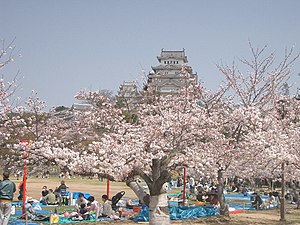 Information: Various flower festivals are held at Shinto shrines during the month of April. Excursions and picnics for enjoying flowers, particularly cherry blossoms are also common, as well as many drinking parties often to be seen in and around auspicious parks and buildings. In some areas the peach blossom, the traditional flower of Japan (the Cherry being a symbol from the Edo period symbolising the Samurai culture), is viewed as well though this flowers earlier than the Cherry. In some places flower viewing parties are held on traditionally fixed dates. This is one of the most popular events during spring. The subject of flower viewing has long held an important place in literature, dance and the fine arts. Ikebana (flower arrangement) is also a popular part of Japanese culture and is still practiced by many people today. Some main things people do during this event are: games, folk songs, folk dance, flower displays, rides, parades, concerts, kimono shows, booths with food and other things, beauty pageant, and religious ceremonies. Families go out during weekends to see the cherry blossoms, and participate in the many festivals and activities.
Information: Various flower festivals are held at Shinto shrines during the month of April. Excursions and picnics for enjoying flowers, particularly cherry blossoms are also common, as well as many drinking parties often to be seen in and around auspicious parks and buildings. In some areas the peach blossom, the traditional flower of Japan (the Cherry being a symbol from the Edo period symbolising the Samurai culture), is viewed as well though this flowers earlier than the Cherry. In some places flower viewing parties are held on traditionally fixed dates. This is one of the most popular events during spring. The subject of flower viewing has long held an important place in literature, dance and the fine arts. Ikebana (flower arrangement) is also a popular part of Japanese culture and is still practiced by many people today. Some main things people do during this event are: games, folk songs, folk dance, flower displays, rides, parades, concerts, kimono shows, booths with food and other things, beauty pageant, and religious ceremonies. Families go out during weekends to see the cherry blossoms, and participate in the many festivals and activities.
Tanabata (七夕)
Information: It originated from a Chinese folk legend concerning two stars-the Weaver Star (Vega) and the Cowherd Star (Altair)-who were said to be lovers who could meet only once a year on the\\ 7th night of the 7th month provided it didn't rain and flood the Milky Way. It was named Tanabata after a weaving maiden from a Japanese legend, named Orihime who was believed to make clothes for the gods. People often write wishes and romantic aspirations on long, narrow strips of coloured paper and hang them on bamboo branches along with other small ornaments.
Bon Festival - Bon (盆)
Information: A Buddhist observance honoring the spirits of ancestors. Usually a "spirit altar" (shōryōdana) is set up in front of the Butsudan (buddhist family altar) to welcome the ancestors' souls. A priest is usually asked to come and read a sutra (tanagyō). Among the traditional preparations for the ancestors' return are the cleaning of grave sites and preparing a path from them to the house and the provision of straw horses or oxen for the ancestors' transportation. The welcoming fire (mukaebi) built on the 13th and the send-off fire (okuribi) built on the 16th are intended to light the path.
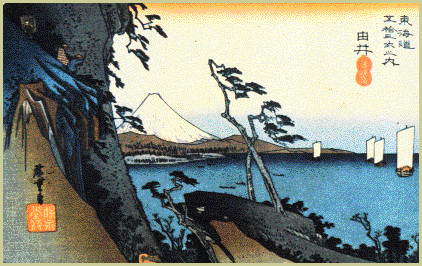


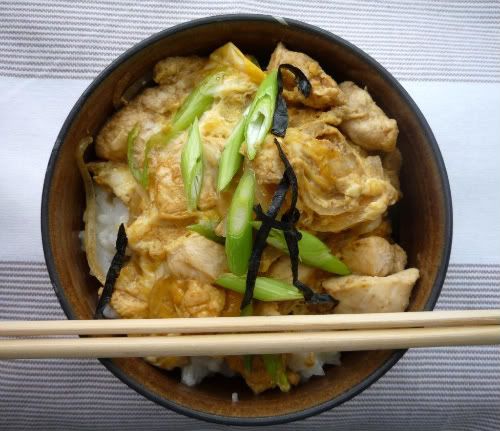

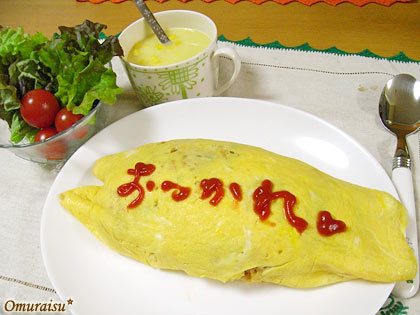


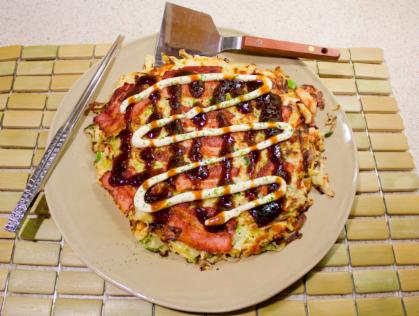
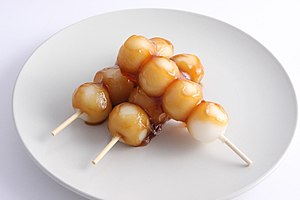












This is amazing culture
ReplyDelete